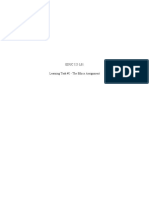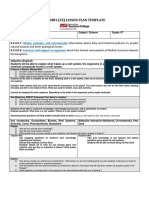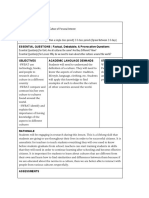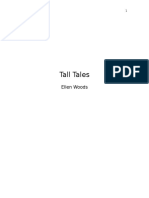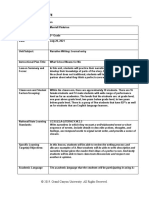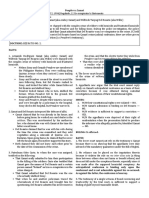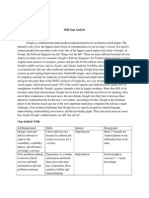Educ 525 lt2
Educ 525 lt2
Uploaded by
api-528997346Copyright:
Available Formats
Educ 525 lt2
Educ 525 lt2
Uploaded by
api-528997346Original Title
Copyright
Available Formats
Share this document
Did you find this document useful?
Is this content inappropriate?
Copyright:
Available Formats
Educ 525 lt2
Educ 525 lt2
Uploaded by
api-528997346Copyright:
Available Formats
1
Learning Task 2
Natasha Chaykowski & Tayler VanRootselaar
Werklund School of Education, University of Calgary
EDUC 525: Ethics and Law in Education
Professor Rhiannon Jones & Teaching Assistant Kashif Raza
October 29th, 2021
Ethical values are what one determines right or wrong connecting to human beliefs.
Anytime race is being brought to terms in a negative light, there are ethical values being
threatened and the situation always escalates. Especially when dealing with other adults abusing
their privilege and who should have a better understanding of the harm it causes. If we were
being represented as the teacher in scenario 1, and the students had expressed their feelings
toward the principal to us, first and foremost our inner values would help us determine what the
principal did was unorthodox. The way we were raised and the decisions we have made in the
past form our character into what it is today, which will affect how we initially view the
situation. With virtue ethics we could argue that the principal’s initial response to the students
was a “sum total of the individual’s character, not a particular calculation in a particular set of
circumstances” (Ethics PowerPoint, 2021), meaning she might not have weighed the
consequences of her actions before speaking and didn’t practice Practical Wisdom. Whether or
not we as the teacher agree with the principal or not, we must keep in mind what the ethical
approach would be while trying to remain unbiased. As the teacher we may be faced with a
Deontological approach where we will be dealing with consequences for our actions. The
principal could be a close friend of ours, however, we must ask ourselves “what is right?” and
“who do we owe the duty to?” (Ethics PowerPoint, 2021).
The students are our number one priority in this case because not only are they
vulnerable, but their ethical rights are being exposed. As teachers we are responsible for our
students and as adults, we need to make sure the other adults within the school are treating the
students with respect. In this case, we would carefully confront the principal face to face about
using the N-word. We would inform her about the meaning behind the word, why it is used,
where it comes from, and how inappropriate and unprofessional it is to use this word, especially
with the hard “-er.” Not only is it inappropriate and unprofessional within the work environment,
but equally so outside of work as well. If she was unsure why she wasn’t allowed to say the
word, but the students of colour were, she needs to be educated before moving forward. Not to
mention if she was unsure about information on a separate topic, she probably would not
approach students to get their opinions in a similar matter as she did in this case. However,
considering that the principal has a position of authority over both the teachers and students it is
crucial to approach this matter in a delicate way to ensure the principal does not get offended and
result to immediate defensive language/actions. Depending on how the principal reacts, that will
determine the next steps and further questioning. In our eyes, she was in the wrong for saying the
word, especially to the students in a school environment.
First, if the principal realized she made a mistake by saying the N-word and apologized
for her actions to the students, student’s families, and school, there should be some forgiveness
and lenience given, especially if she is willing to educate herself further on the topic.
Unfortunately, when dealing with race, as a teacher we still should report the incident no matter
what because blatant racism poses a safety issue to all students. The principal is the face of the
school, therefore, many teachers, students, parents, and even the surrounding community will
have a certain judgement toward that school now. When someone enters the education
profession, they are made well aware of the image they need to uphold both inside and outside of
the schools. As the principal she must follow the Alberta Teaching Quality Standard and her
actions clearly go against it. The TQS states that “Alberta teachers provide inclusive learning
environments in which diversity is respected and members of the school community are
welcomed, cared for, respected and safe” (Alberta Education, 2018). The principal’s attitude
towards the situation did not reflect the TQS and therefore, there needs to be consequences to her
actions. When receiving this information from the students, it is a teacher’s right to “protect
against discrimination on the basis of prejudice as to race, colour, physical characteristics, place
of origin, place of residence, and have the responsibility to refrain from practising these forms of
discrimination in their professional duties.” (TATA, 2018b). Like we mentioned before, the
principal may not understand where this word comes from because it is rooted through a certain
community. It is the principal’s duty to be educated on the topic and actively work towards not
discriminating her students. Furthermore, she should be striving to create an anti-racist
environment for all her students to feel safe while at school. We do not know what our students’
home lives are like so as educators we should be ensuring that students at least have a safe place
when they come to school.
Moving forward with the scenario, we would also question why the students were
suspended and the principal was not? Usually in authoritative positions, where discipline is part
of the job description, they would still have to act in a professional manner to give punishments.
She could have stepped in and asked the students “We do not use that kind of language in this
school, how is it you can say words like that, and others can’t?” If the principal went about the
situation in this professional manner, it was her place to give consequences to the students for
violating what she thought was affecting the learning environment. We could compare this to a
similar situation, if she were to catch students cussing using the f-word for example, she
probably would not approach the students by saying “We do not say ‘f-word’”. Instead, she
would address the students by saying something along the lines of “We do not say cuss words
while we are at school. These are not nice words to be using”. So, by comparison the principal
should have known it was inappropriate to say the real N-word to her students rather than asking
her question using professional language. Her thoughts are protected under section 2 of the
Declaration of Rights and Responsibilities for Teachers, “Standards of pupil behaviour necessary
for maintaining an optimal learning environment and have the responsibility to use reasonable
methods to achieve such standards.” (TATA, 2018b). However, her methods are not deemed
reasonable under the circumstances.
Unfortunately, she did not use her professionalism which now leaves her with
consequences to face. We compared this scenario with the Ross v New Brunswick case study, the
consequences of the principal would be the same, if not worse. Ross was “no longer employed
by the School Board” (1996). Why we suggest the consequences should be worsened for the
principal in our scenario is because of the environment the incident took place in. Ross was off
school grounds when making racist remarks, whereas this principal was talking with students on
school property. At the very least the principal should be required to take anti-racism classes and
courses on diversity equity and inclusion (DE&I) before she should be allowed to resume her
role as the school’s principal. In any case we need to ensure that the students are taken care of
first and foremost because they are vulnerable, so we need to ensure their safety in every way we
can. Principals are the main face of a school and therefore should be held to the highest standard
when it comes to how they treat their students and staff. By not punishing the principal for her
misconduct it sets a precedent that the principal can do whatever she pleases without
consequences, which will not look good to the community and parents.
References
(2021). Ethics PowerPoint slides. University of Calgary: Desire2Learn. Retrieved from https://
d2l.ucalgary.ca/d2l/le/content/400446/viewContent/4965069/View
Alberta Education. (2018). Teaching quality standard. Alberta Government. Retrieved from
https://open.alberta.ca/dataset/4596e0e5-bcad-4e93-a1fb-dad8e2b800d6/resource/
75e96af5-8fad-4807-b99a-f12e26d15d9f/download/edc-alberta-education-teaching-quality-
standard-2018-01-17.pdf
The Alberta Teachers Association. (2018a). Code of professional conduct. Retrieved https://
www.teachers.ab.ca/SiteCollectionDocuments/ATA/Publications/Teachers-as-Professionals/
IM-4E%20Code%20of%20Professional%20Conduct.pdf
The Alberta Teachers Association. (2018b). Declaration of rights and responsibilities for
teachers. Retrieved https://www.teachers.ab.ca/SiteCollectionDocuments/ATA/Publications/
Teachers-as-Professionals/IM-5E%20Declaration%20of%20Rights.pdf
Ross v. New Brunswick School District No. 15, 1996 CanLII 237 (SCC), [1996] 1 SCR 825
https://www.canlii.org/en/ca/scc/doc/1996/1996canlii237/1996canlii237.html
You might also like
- Strategies For Adressing Metaethical Issues in EducationDocument4 pagesStrategies For Adressing Metaethical Issues in EducationGARIKAI KATSERENo ratings yet
- Educ 551 lt3 Self Reflection Letter Rick Simms Ucid 30016645Document7 pagesEduc 551 lt3 Self Reflection Letter Rick Simms Ucid 30016645api-538027450No ratings yet
- Lesson Plan Template: GCU College of EducationDocument4 pagesLesson Plan Template: GCU College of Educationapi-505412890No ratings yet
- AN INSPECTOR CALLS' Activity WorksheetsDocument12 pagesAN INSPECTOR CALLS' Activity WorksheetsstephaniecrossNo ratings yet
- lt2 525 FinalDocument10 pageslt2 525 Finalapi-589803497No ratings yet
- 9 - StatesofMatterScavengerHunt PDFDocument1 page9 - StatesofMatterScavengerHunt PDFkimNo ratings yet
- Anglophone School District - North: Grade 5 Science - Unit Lesson Guide Properties and Changes in MaterialsDocument51 pagesAnglophone School District - North: Grade 5 Science - Unit Lesson Guide Properties and Changes in MaterialsZuyin AeneahNo ratings yet
- Susan Wilson Educ 551 Assignment 1 Letter To Administration TeamDocument3 pagesSusan Wilson Educ 551 Assignment 1 Letter To Administration TeamSusan WilsonNo ratings yet
- Poetry Lesson 3 - SimilesDocument6 pagesPoetry Lesson 3 - Similesapi-213611948No ratings yet
- Educ 525 lt2Document6 pagesEduc 525 lt2api-445253818No ratings yet
- Social Studies - Grade 5Document3 pagesSocial Studies - Grade 5api-278663194No ratings yet
- Blanket Lesson PlanDocument4 pagesBlanket Lesson Planapi-272545554No ratings yet
- Figurative LanguageDocument2 pagesFigurative Languagemenchie ferrerNo ratings yet
- Simile Metaphor FinalDocument3 pagesSimile Metaphor FinalJudenable MjNo ratings yet
- SLG UnitDocument44 pagesSLG Unitapi-319172800No ratings yet
- Unit Plan - Story Theatre Grade 5Document13 pagesUnit Plan - Story Theatre Grade 5api-535058890No ratings yet
- Lesson Plan Hsie 2 9 14 AnnotatedDocument2 pagesLesson Plan Hsie 2 9 14 Annotatedapi-267872894No ratings yet
- Literacy Lesson Plan First DraftDocument5 pagesLiteracy Lesson Plan First DraftMelina VarneyNo ratings yet
- PBL Lesson Plan TemplateDocument2 pagesPBL Lesson Plan Templateapi-488912445No ratings yet
- Hass Lesson SequenceDocument6 pagesHass Lesson Sequenceapi-332081681No ratings yet
- Definition of Shared ReadingDocument2 pagesDefinition of Shared ReadinghidayahNo ratings yet
- Learning MapDocument11 pagesLearning MapSamantha HoodNo ratings yet
- Day 1 Lesson Plan 1Document5 pagesDay 1 Lesson Plan 1api-347944259No ratings yet
- Metaphorical Expression Lesson - MLKDocument3 pagesMetaphorical Expression Lesson - MLKapi-315872239No ratings yet
- Professional Semester III Growth Plan - Amber MackintoshDocument7 pagesProfessional Semester III Growth Plan - Amber Mackintoshapi-266794577No ratings yet
- Unit Planner: (ACELT1581) (ACELT1582) (ACELT1584) (ACELT1586)Document5 pagesUnit Planner: (ACELT1581) (ACELT1582) (ACELT1584) (ACELT1586)api-464562811No ratings yet
- Assessment Two - Gemma CraigDocument8 pagesAssessment Two - Gemma Craigapi-458955453No ratings yet
- Content Area Lesson PlanDocument10 pagesContent Area Lesson Planapi-583719242No ratings yet
- Group Members/Group Name: Thematic Unit Theme: Lesson 2 Title: Grade Level: Group Weebly Space AddressDocument8 pagesGroup Members/Group Name: Thematic Unit Theme: Lesson 2 Title: Grade Level: Group Weebly Space Addressapi-402126047No ratings yet
- Unit Plan Science 5th GradeDocument5 pagesUnit Plan Science 5th GradeNatalie ShaldaNo ratings yet
- Artifacts and Reflections On Intasc StandardsDocument27 pagesArtifacts and Reflections On Intasc Standardsapi-301871601No ratings yet
- Day/Hour 1 Day/Hour 2 Day/Hour 3 Day/Hour 4 Day/Hour 5: CalendarDocument2 pagesDay/Hour 1 Day/Hour 2 Day/Hour 3 Day/Hour 4 Day/Hour 5: CalendarMorganNo ratings yet
- Ismail Dennisa Edn567 Assign1Document6 pagesIsmail Dennisa Edn567 Assign1api-354656077No ratings yet
- Untitleddocument 2Document6 pagesUntitleddocument 2api-339193750No ratings yet
- FPD Science PDFDocument22 pagesFPD Science PDFapi-397550706No ratings yet
- Light Fantastic UnitDocument2 pagesLight Fantastic Unitapi-232002863No ratings yet
- Lesson Plan Form - 6th GradeDocument3 pagesLesson Plan Form - 6th GradeBrigitte NoveloNo ratings yet
- Tall TalesDocument18 pagesTall Talesapi-353798415No ratings yet
- Ell Classroom Observation ReportDocument3 pagesEll Classroom Observation Reportapi-262715288No ratings yet
- Dream School Plan-Ignite AcademyDocument7 pagesDream School Plan-Ignite Academyapi-359891375100% (1)
- Poetry Café Unit PlanDocument10 pagesPoetry Café Unit PlanKaitlynScottNo ratings yet
- Classroom Management Plan Template1Document8 pagesClassroom Management Plan Template1api-319663115No ratings yet
- Fifth Grade Social Studies Unit PlanDocument19 pagesFifth Grade Social Studies Unit Planapi-591042996No ratings yet
- ITL 518 Learning MapDocument8 pagesITL 518 Learning MapJeffrey haroNo ratings yet
- Newsela Lesson PlanDocument2 pagesNewsela Lesson Planapi-355403404No ratings yet
- Melanie Cella Unit Plan 3 Grade Topic: Animals and EcosystemsDocument42 pagesMelanie Cella Unit Plan 3 Grade Topic: Animals and Ecosystemsapi-384066525No ratings yet
- Kelceys Ell Lesson PlanDocument7 pagesKelceys Ell Lesson Planapi-300746636No ratings yet
- EDUC 5010 Unit 3 Written AssignmentDocument7 pagesEDUC 5010 Unit 3 Written AssignmentSabrina Coppin-KellmanNo ratings yet
- Udl AssignmentDocument9 pagesUdl Assignmentapi-491447486No ratings yet
- English Planning Term 2 - CarrianneDocument22 pagesEnglish Planning Term 2 - Carrianneapi-315385324No ratings yet
- TPA 2 - ReflectionDocument4 pagesTPA 2 - Reflectionmmorris21No ratings yet
- Reflect and ConnectDocument4 pagesReflect and Connectapi-390725209No ratings yet
- Social Studies Unit Plan Formal LessonDocument6 pagesSocial Studies Unit Plan Formal Lessonapi-336937856100% (1)
- Big Ideas Essential Questions: Seton Hill University Lesson Plan Template Name Subject Grade Level Date/DurationDocument4 pagesBig Ideas Essential Questions: Seton Hill University Lesson Plan Template Name Subject Grade Level Date/Durationapi-266477631No ratings yet
- English Unit Planner - Term 4Document3 pagesEnglish Unit Planner - Term 4api-530415478No ratings yet
- Lesson Plan Template: GCU College of EducationDocument6 pagesLesson Plan Template: GCU College of EducationMontell Pinkston100% (1)
- Lesson Plan 1 Insects TaughtDocument11 pagesLesson Plan 1 Insects Taughtapi-270233181No ratings yet
- EdTPA Lesson PlanDocument6 pagesEdTPA Lesson PlanStephen Schultheis0% (1)
- Ted Language AutobiographyDocument4 pagesTed Language Autobiographyapi-406405879No ratings yet
- The Gold Coast Transformed: From Wilderness to Urban EcosystemFrom EverandThe Gold Coast Transformed: From Wilderness to Urban EcosystemTor HundloeNo ratings yet
- The Importance of Developing Reading for Improved Writing Skills in the Literature on Adult Student's LearningFrom EverandThe Importance of Developing Reading for Improved Writing Skills in the Literature on Adult Student's LearningNo ratings yet
- République Du Cameroun Republic of Cameroon: Notes On Farm ManagamentDocument9 pagesRépublique Du Cameroun Republic of Cameroon: Notes On Farm ManagamentabdoulayNo ratings yet
- Somosa-Ramos vs. Vamenta Digest (Legal Separation)Document1 pageSomosa-Ramos vs. Vamenta Digest (Legal Separation)Klein Charisse Abejo100% (1)
- Mission Statements of NikeDocument12 pagesMission Statements of Nikemkam212No ratings yet
- Rowman Littlefield. Globalization and Postcolonialism .Sankaran Krishna. (2008) PDFDocument235 pagesRowman Littlefield. Globalization and Postcolonialism .Sankaran Krishna. (2008) PDFFernandaNo ratings yet
- Accomplishment Report Book Week CelebrationDocument4 pagesAccomplishment Report Book Week CelebrationgeonzonloveliaNo ratings yet
- Philippine Indigenous CommunitiesDocument5 pagesPhilippine Indigenous CommunitiesRecca MayNo ratings yet
- Harish 2009Document4 pagesHarish 2009maruthi631No ratings yet
- Ode To West Wind MCQsDocument6 pagesOde To West Wind MCQsMazhar Hussain100% (5)
- People vs. CamatDocument2 pagesPeople vs. CamatRuth Lumibao67% (3)
- 2014 Doctor LetterDocument1 page2014 Doctor LetterMukesh WarrierNo ratings yet
- Extreme ProgrammingDocument4 pagesExtreme ProgrammingpavithraNo ratings yet
- 100 DDB Stories From The 1960'sDocument87 pages100 DDB Stories From The 1960'sPraful BawejaNo ratings yet
- Dr. Saboor.3 PDFDocument5 pagesDr. Saboor.3 PDFMuhammad IshtiaqNo ratings yet
- Chapter 4Document3 pagesChapter 4Ak AlNo ratings yet
- Messianism 20Document9 pagesMessianism 20Jesse GlaserNo ratings yet
- Caliban and Ariel Are Two Contrasting CharactersDocument2 pagesCaliban and Ariel Are Two Contrasting CharactersMence Ristova100% (1)
- Holy Clubs and Tuesday Meetings: Page of 1 2Document2 pagesHoly Clubs and Tuesday Meetings: Page of 1 2angelu777No ratings yet
- ErythromycinDocument6 pagesErythromycinkitsilcNo ratings yet
- Pan-Assessment Tool Grade-1 FinalDocument4 pagesPan-Assessment Tool Grade-1 FinalMaestro Varix100% (2)
- Mimochai Studio Drawing Foundations Workbook PDFDocument32 pagesMimochai Studio Drawing Foundations Workbook PDFWilliam Eduardo Cuevo GomezNo ratings yet
- Is Homework Harmful or HelpfulDocument5 pagesIs Homework Harmful or Helpfulafeuceblj100% (1)
- Resume: Name:Srilatha Phone: +91-9494171851Document2 pagesResume: Name:Srilatha Phone: +91-9494171851AshokSmileyNo ratings yet
- Joola Blade Comparison PDFDocument1 pageJoola Blade Comparison PDFdwiNo ratings yet
- La Dieta Gracie (Ingles)Document57 pagesLa Dieta Gracie (Ingles)cepolNo ratings yet
- Dynamics of MachineryDocument15 pagesDynamics of MachinerySabareeswaran MurugesanNo ratings yet
- VIVIBHA - Rules and Regulations Research Paper Writing CompetitionDocument6 pagesVIVIBHA - Rules and Regulations Research Paper Writing CompetitionGoutam GuptaNo ratings yet
- E8 Đề cương ôn thi giữa HK 1 2024-2025Document3 pagesE8 Đề cương ôn thi giữa HK 1 2024-2025Thiện Hoàng NgọcNo ratings yet
- Exam Question Pack SZDocument15 pagesExam Question Pack SZzoelegge24No ratings yet
- Gap AnalysisDocument2 pagesGap AnalysisCarol LeeNo ratings yet









